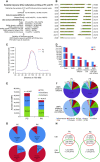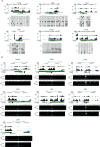High-frequency aberrantly methylated targets in pancreatic adenocarcinoma identified via global DNA methylation analysis using methylCap-seq
- PMID: 25276247
- PMCID: PMC4177372
- DOI: 10.1186/1868-7083-6-18
High-frequency aberrantly methylated targets in pancreatic adenocarcinoma identified via global DNA methylation analysis using methylCap-seq
Abstract
Background: Extensive reprogramming and dysregulation of DNA methylation is an important characteristic of pancreatic cancer (PC). Our study aimed to characterize the genomic methylation patterns in various genomic contexts of PC. The methyl capture sequencing (methylCap-seq) method was used to map differently methylated regions (DMRs) in pooled samples from ten PC tissues and ten adjacent non-tumor (PN) tissues. A selection of DMRs was validated in an independent set of PC and PN samples using methylation-specific PCR (MSP), bisulfite sequencing PCR (BSP), and methylation sensitive restriction enzyme-based qPCR (MSRE-qPCR). The mRNA and expressed sequence tag (EST) expression of the corresponding genes was investigated using RT-qPCR.
Results: A total of 1,131 PC-specific and 727 PN-specific hypermethylated DMRs were identified in association with CpG islands (CGIs), including gene-associated CGIs and orphan CGIs; 2,955 PC-specific and 2,386 PN-specific hypermethylated DMRs were associated with gene promoters, including promoters containing or lacking CGIs. Moreover, 1,744 PC-specific and 1,488 PN-specific hypermethylated DMRs were found to be associated with CGIs or CGI shores. These results suggested that aberrant hypermethylation in PC typically occurs in regions surrounding the transcription start site (TSS). The BSP, MSP, MSRE-qPCR, and RT-qPCR data indicated that the aberrant DNA methylation in PC tissue and in PC cell lines was associated with gene (or corresponding EST) expression.
Conclusions: Our study characterized the genome-wide DNA methylation patterns in PC and identified DMRs that were distributed among various genomic contexts that might influence the expression of corresponding genes or transcripts to promote PC. These DMRs might serve as diagnostic biomarkers or therapeutic targets for PC.
Keywords: CGI shore; DNA methylation; genome-wide; methyl capture sequencing; orphan CGI; pancreatic adenocarcinoma.
Figures



References
-
- Ma C, Jiang YX, Liu SZ, Quan PL, Sun XB, Zheng RS, Zhang SW, Chen WQ. Trend and prediction on the incidence of pancreatic cancer in China. Zhonghua Liu Xing Bing Xue Za Zhi. 2013;34(2):160–163. - PubMed
LinkOut - more resources
Full Text Sources
Other Literature Sources
Molecular Biology Databases
Research Materials

